Remember those summer days when your parents loaded everyone into the station wagon for a day at the amusement park? Long before digital safety systems and elaborate theming, classic rides delivered thrills through simplicity, speed, and sometimes questionable safety standards that would make today’s lawyers break into a cold sweat. Those vintage attractions hold a special place in our hearts—experiences that simultaneously terrified us and kept us coming back for “just one more ride” until the park closed. From wooden roller coasters that felt like they might collapse at any moment to spinning contraptions that defied both gravity and common sense, these classic rides created memories that have lasted a lifetime. Let’s take a nostalgic journey back to the amusement parks of yesteryear and celebrate 12 classic rides that were equal parts terrifying and irresistible.
1. The Wooden Roller Coaster
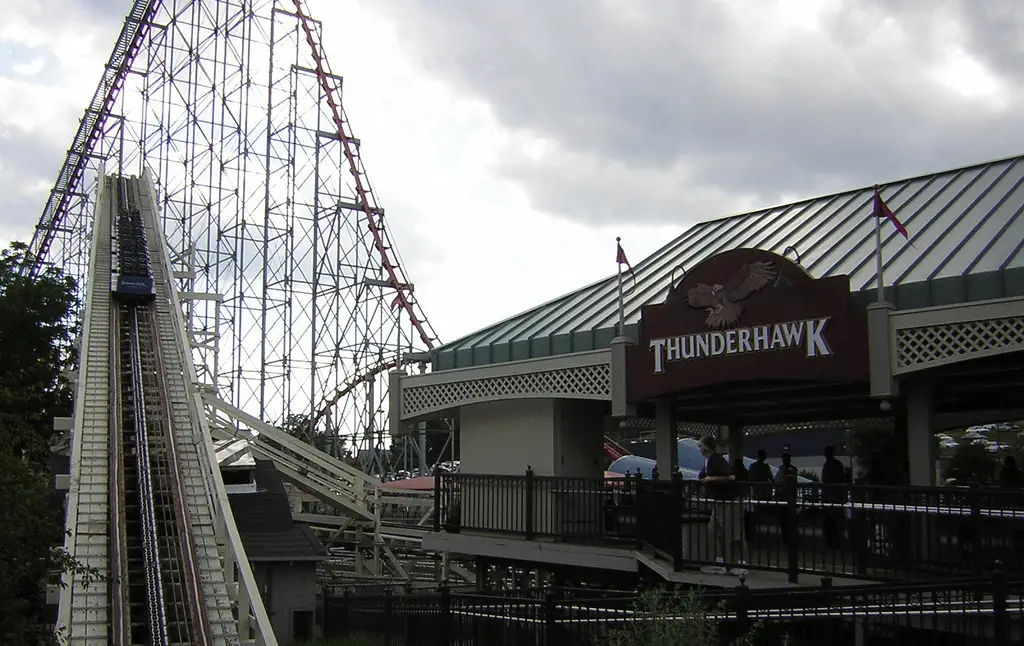
The thunderous roar of the wooden roller coaster announced its presence long before you could see it, with its massive structure dominating the park skyline like an intricate wooden sculpture. Each ride began with that slow, tension-building climb, the distinctive click-click-click of the chain lift creating a rhythm that matched your increasing heartbeat as you inevitably questioned the wisdom of your decision. The knowledge that this rickety-looking wooden structure was assembled decades ago—and the strange creaking sounds that accompanied every twist and turn—somehow enhanced rather than diminished the thrill. HowStuffWorks breaks down how exactly these revolutionary rollercoasters worked in the early days of thrilling rides.
What made wooden coasters uniquely terrifying was the genuine feeling that you were one loose bolt away from disaster, combined with the bone-jarring roughness that tossed you around the seat despite the minimal restraints. The Cyclone at Coney Island, the Giant Dipper at Santa Cruz, or your local park’s wooden monster delivered a kind of visceral, unfiltered fear that today’s smoother, more engineered steel coasters can’t quite replicate. Those precious seconds of airtime when you were lifted from your seat, secured by nothing but a single lap bar and perhaps the sweaty grip of your older sibling, created the perfect combination of legitimate fear and exhilarating joy that had you racing back to the end of the line.
2. The Gravitron/Rotor
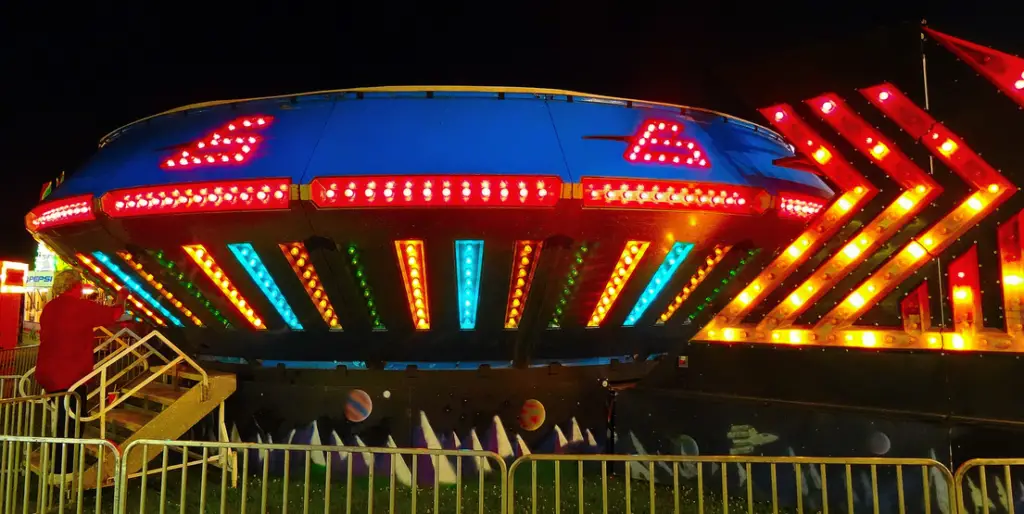
The Gravitron (sometimes called the Rotor) looked innocent enough from the outside—a large cylinder that seemed less threatening than the nearby coasters—until you stepped inside and realized the floor would literally disappear beneath your feet. After selecting your spot against the padded wall, the operator would start the rotation, gradually increasing speed until centrifugal force pinned you helplessly in place as the floor dropped away. The strange sensation of being simultaneously immobilized and utterly unsecured created a unique form of panic, especially when the operator increased the rotation speed just when you thought it couldn’t go faster. Trivia Happy takes a spin at some surprising secrets about this thrilling ride.
The true terror came from watching fellow riders slide uncomfortably up the wall or attempt ill-advised stunts like turning upside down, all while carnival workers casually walked around the sunken center platform eyeing the machinery. Social dynamics inside the Gravitron were fascinating—the cool teenagers attempting to look unimpressed while secretly white-knuckling the experience, someone inevitably getting sick (though thankfully centrifugal force usually kept the mess pinned to the wall), and the strange bonding that came from shared vulnerability while trapped in a spinning cylinder. The relief when the ride finally slowed and you discovered your legs still worked was matched only by the peculiar dizziness that had you staggering like you’d sampled too much of what the adults kept in their coolers in the picnic area.
3. The Scrambler
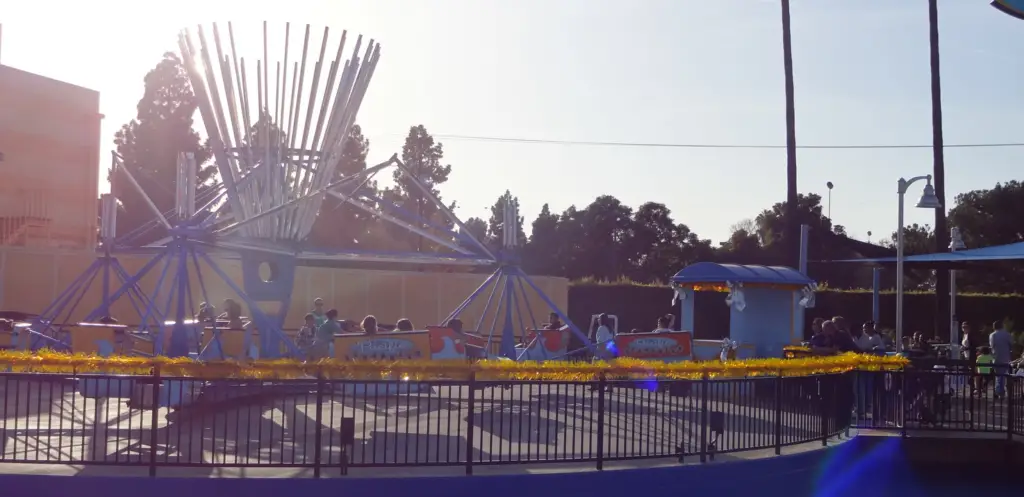
The Scrambler combined multiple rotational forces that seemed specifically designed to test the limits of your lunch’s stability, as three separate spinning motions simultaneously pulled you in different directions. What began as a reasonably gentle spin quickly escalated into a frenzy of centrifugal chaos that invariably resulted in the smallest person on the seat being crushed against the largest, regardless of where they started. The ride operator often seemed to derive particular joy from extending the ride time just when the rotation appeared to be slowing, triggering groans that were equal parts protest and delight. Mental Floss delves into the history of this and several other classic coasters and rides that have had our hearts pounding for decades.
The true terror of the Scrambler came from its deceptive appearance—it looked tame enough that parents and grandparents would join the ride, only to regret their decision within seconds of the first spin. Sharing the small seat with family members created an unavoidable physical intimacy as you slammed repeatedly into each other, accompanied by desperate pleas to “move over” despite the physical impossibility of resisting the forces in play. The distinctive sweeping colorful canopy overhead became a psychedelic blur as you alternated between laughter and genuine concern about the laws of physics, creating a sensory overload that left you wobbling back to solid ground with a disoriented grin.
4. The Zipper
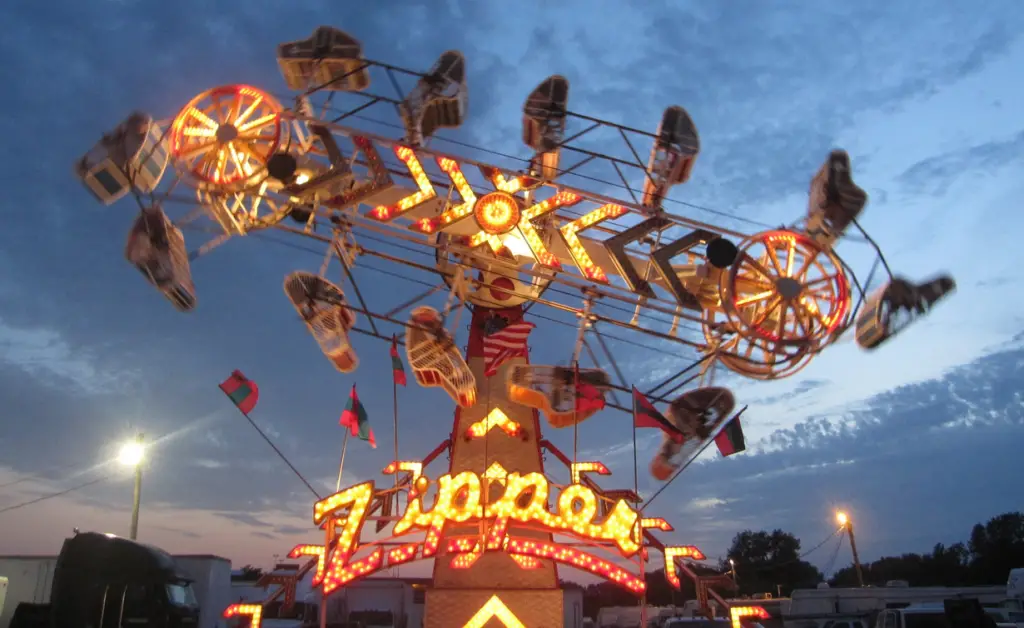
The Zipper combined every element that safety engineers now have nightmares about—cages that freely flipped forward and backward, a main boom that rotated vertically, and a secondary rotation that ensured no rider could predict which direction they’d be facing next. Loading into the metal cage felt like willingly entering a medieval torture device, complete with a door that latched shut with an ominous clank that suggested this might be your final decision. Each cage contained just enough room for two people to be intimately acquainted with each other’s terror, with nothing but a thin bar across the lap and the cage itself to prevent falling.
Riders quickly discovered that leaning forward or backward could influence the cage’s rotation, creating a false sense of control that inevitably led to regret when the main boom’s movement overpowered your efforts. The moment the ride reached full speed created a chaotic symphony of screams, rattling metal, and the distinct sound of loose change and keys falling from pockets to the ground below—a donation to the amusement park gods. The Zipper’s combination of unpredictable flipping, stomach-dropping falls, and moments of being completely inverted while suspended high above the midway created an experience that was equal parts terrifying and addictive—though you needed at least ten minutes afterward to regain your equilibrium and courage.
5. The Tilt-A-Whirl
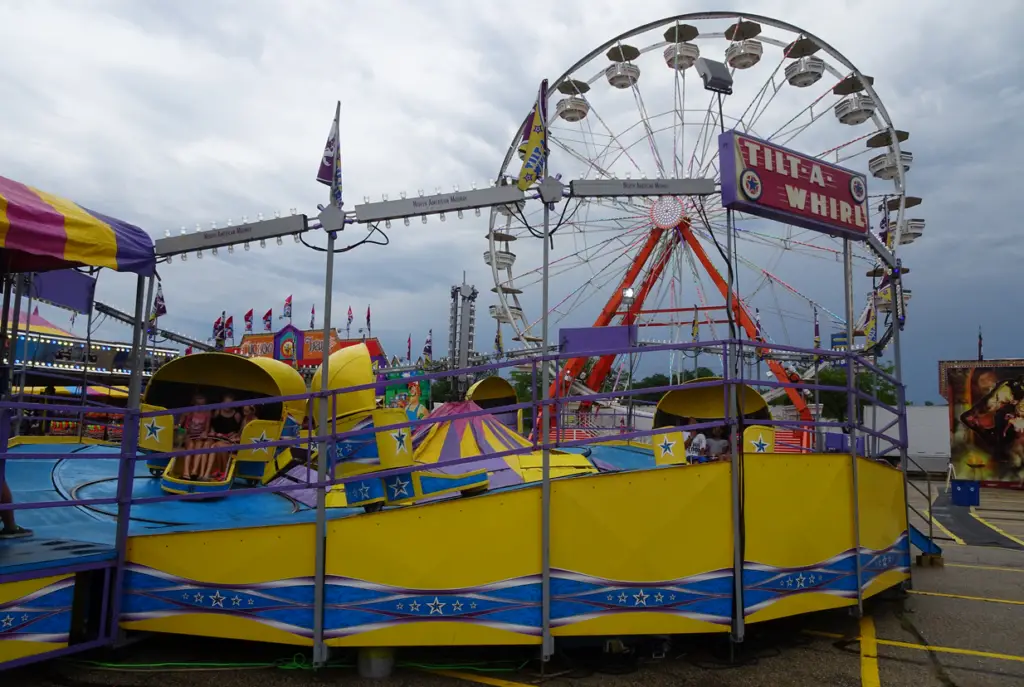
The Tilt-A-Whirl’s innocent-looking cars sitting on undulating tracks concealed the physics-defying spin that would soon have you questioning your decision-making abilities. The genius of this ride was its unpredictability—no two rides were ever the same, as the weighted cars spun with varying intensity depending on the distribution of passengers and the mysterious whims of centrifugal force. The distinct sound of the metal wheels along the track, combined with the characteristic sudden whipping motion that could occur without warning, created a suspenseful experience where anticipation was half the thrill.
The social dynamics of the Tilt-A-Whirl were uniquely interactive as riders quickly learned that leaning into turns could dramatically increase spinning—knowledge that split passengers into competing camps of those trying to maximize rotation and those desperately praying for it to end. The ride’s deceiving appearance led many grandparents to volunteer as chaperones, only to find themselves trapped in a whirling vortex controlled by gleeful children intentionally throwing their weight to achieve maximum spin. The distinctive fiberglass cars with their abstract painted designs became blurry kaleidoscopes as they spun, matching the disoriented state of mind that had you stumbling away afterward, promising both “never again” and “just one more time” in the same breath.
6. The Paratrooper
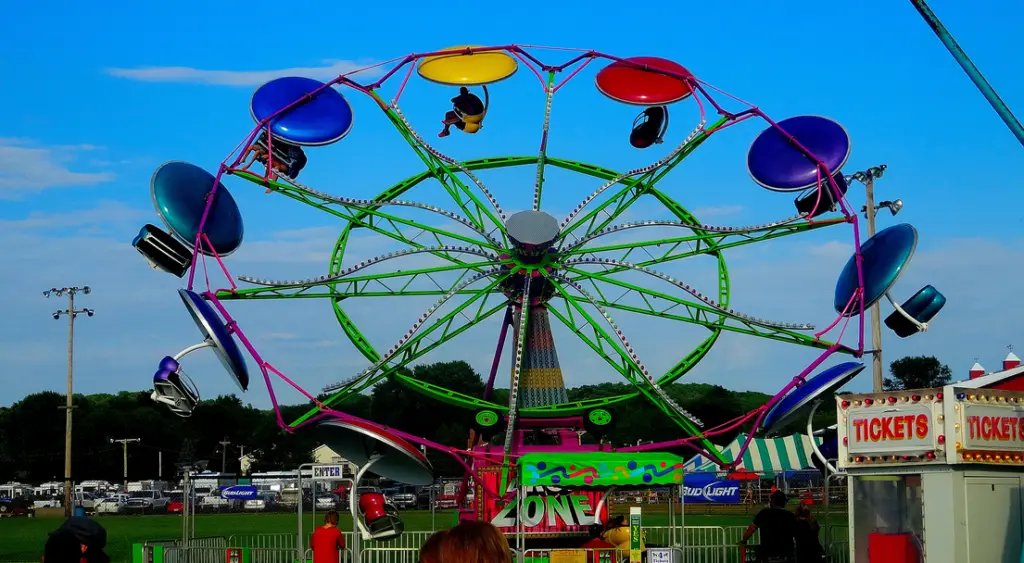
The Paratrooper suspended riders in two-person seats beneath rainbow-colored parachute canopies, creating an initially gentle experience that became increasingly terrifying as it gained both speed and elevation. The dual motion of the main arm rotating while the individual seats swung outward created a floating sensation on the upswing followed by stomach-dropping acceleration on the downswing. What looked from the ground like a leisurely sky ride revealed its true nature once the operator maxed out the speed, turning those cute parachute canopies into a blur of color as centrifugal force tested the strength of both the equipment and your resolve.
The minimal restraint system—often just a single metal bar across the lap—added an element of genuine concern, especially at maximum elevation when the seats swung nearly parallel to the ground. The peculiar vulnerability of having your feet dangling freely with nothing below but air created a unique form of anxiety, especially when the ride operator demonstrated the variable speed control by alternating between surprisingly fast rotations and almost-stops that left you swinging awkwardly. The beautiful choreography of the ride in full motion, with its synchronized rainbow of swinging parachutes, created a visual spectacle for those safely on the ground that belied the white-knuckled experience of those holding on for dear life above.
7. The Wild Mouse
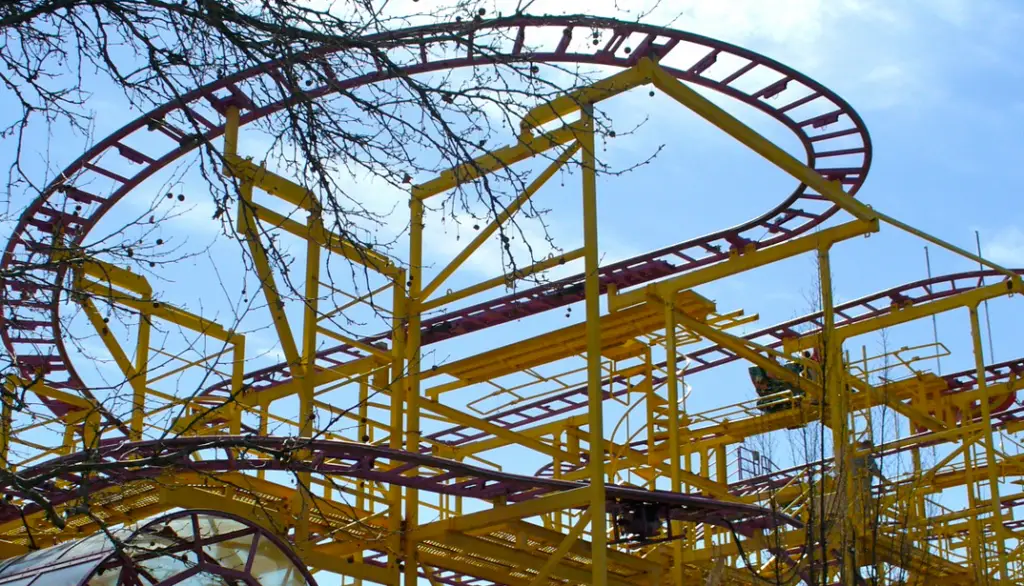
The Wild Mouse coaster replaced the smooth curves of traditional coasters with jarring right-angle turns that convinced every rider they were about to be ejected from the track. The small individual cars, often designed to look like mice or other small creatures, created an exposed feeling unlike the longer trains of traditional coasters, making each sharp turn feel personally targeted at your equilibrium. The tracks appeared terrifyingly narrow from your seat, creating the persistent illusion that the wheels were seconds away from slipping off the rail entirely, especially during the signature move where the car approached the edge of the platform and seemed to teeter momentarily before making its abrupt turn.
The compact design meant that Wild Mouse coasters packed their terror into a smaller footprint, substituting the grand heights of traditional coasters with relentless direction changes and the psychological fear that the small car simply couldn’t handle the forces involved. The minimal padding in the cars ensured you felt every bump, jolt, and direction change with spine-adjusting clarity, often resulting in a distinctive side-to-side head rattling that became part of the experience. The final brilliance of the Wild Mouse was how it democratized coaster riding—its less intimidating appearance lured in those who avoided larger coasters, only to deliver an equally terrifying experience through unexpected methods, creating a new generation of thrill-seekers who returned with a newly acquired taste for adrenaline.
8. The Enterprise
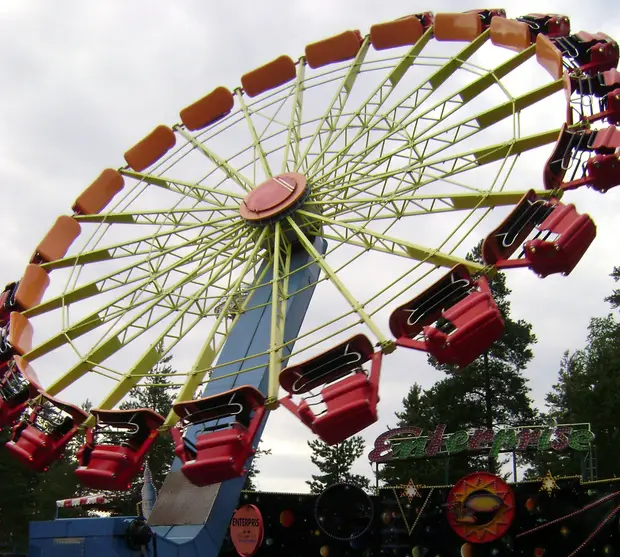
The Enterprise began innocently enough with riders boarding circular gondolas arranged around a giant wheel, initially sitting upright as though on a normal Ferris wheel. As the ride accelerated, the entire wheel tilted upward until it rotated completely vertically, subjecting riders to forces that pinned them against the back of their cages while they traveled in full 360-degree loops. The lack of seat belts or harnesses—relying entirely on centrifugal force to keep riders in place—created a uniquely terrifying feeling of being simultaneously secure and utterly vulnerable.
The moment when the wheel first tilted to vertical created a primal fear response, as your brain struggled to understand why you weren’t falling despite being completely inverted at the top of the rotation. The Enterprise created a strange sensory contradiction—the physical sensation of being firmly pressed against the padded back wall while visually experiencing complete inversion as the ground and sky traded places repeatedly. The gradual slowing of the ride brought its own terror as riders anxiously wondered at exactly what point the centrifugal force would become insufficient to keep them in place, creating a unique bond between strangers united in the same existential physics question.
9. The Haunted House

The vintage Haunted House dark ride combined questionable mechanical scares with the more powerful tool of anticipatory dread, as your slow-moving car squeaked along tracks through pitch-black corridors. The knowledge that something would jump out—but not knowing exactly when—created a tension that had riders either covering their eyes or staring intently into the darkness, neither option preventing the inevitable scream when a glowing skeleton suddenly appeared inches from your face. The jerky movement of the ride cars added to the unease, especially when they unexpectedly stopped in particularly dark sections, leaving riders to wonder if it was a mechanical failure or an intentional pause to maximize anxiety.
The low-tech nature of classic haunted houses—with their black-lit paintings, air-blast surprises, and mechanically operated ghouls—somehow made them more terrifying than today’s sophisticated equivalents, perhaps because their handmade quality tapped into deeper childhood fears. The shared experience created unique social dynamics as friends and family members competed to appear unafraid while simultaneously using each other as human shields. The final drop or spin that many haunted houses incorporated as a surprise ending ensured that even veteran riders who had memorized the location of every scare would still leave with elevated heart rates, usually immediately getting back in line to experience the perfect combination of fear and fun all over again.
10. The Pirate Ship

The giant swinging Pirate Ship created a pendulum of escalating terror as it gained momentum with each swing, eventually reaching heights that had riders convinced they were about to make a complete 360-degree loop despite the ride’s design limitations. The anticipatory moment at the apex of each swing, when the ship momentarily paused before reversing direction, created a suspended-in-time sensation of weightlessness followed by the stomach-dropping acceleration of the downswing. The communal nature of the experience—with everyone facing inward watching fellow riders’ expressions change from excitement to terror—created a contagious atmosphere where screams rippled across the ship in waves.
The minimal restraint systems, often just a single bar across a whole row, did little to alleviate the feeling that you might be launched into space at the height of each swing. The psychological impact of watching the ground approach at increasing speeds, then swing away just as dramatically, triggered instinctive panic responses no matter how much your rational mind understood the physics involved. The ride’s extended duration, which often seemed to continue long past what seemed reasonable, created a peculiar transformation in riders, who typically progressed from excitement to terror to a kind of delirious acceptance—followed by renewed screaming when the operator gave it “just a few more swings” just when you thought it was finally slowing down.
11. The Octopus/Spider
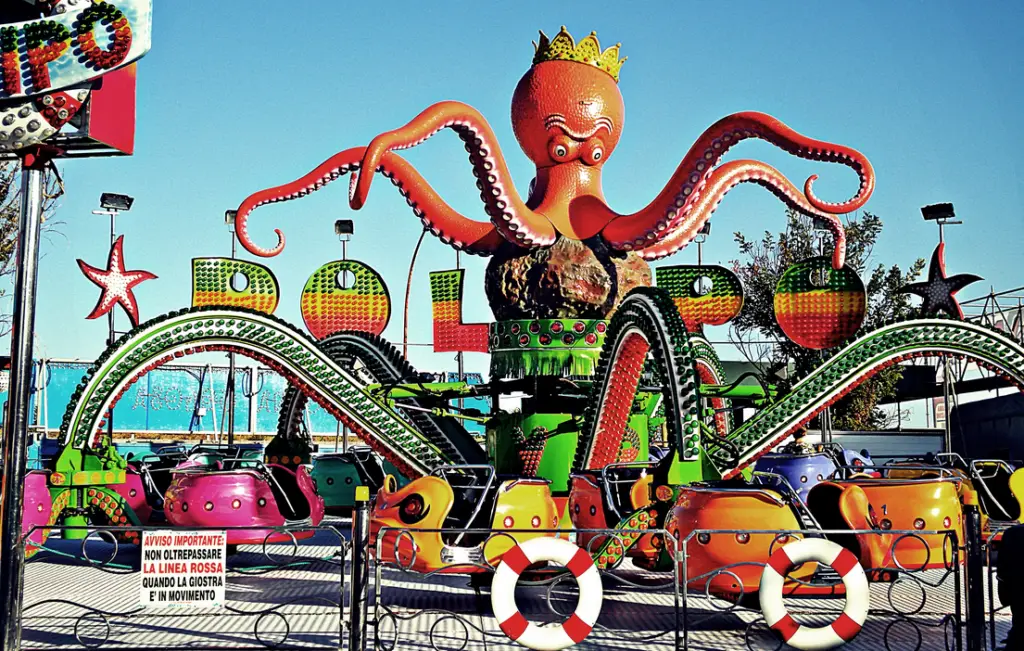
The Octopus (sometimes called the Spider) combined multiple rotation points that ensured no rider’s experience was quite the same, as individual cars spun on their own axes while the arms they were attached to also rotated around a central hub. The unpredictable nature of the ride meant you never knew when your particular car would suddenly accelerate into a spin or when the main rotation would synchronize with your car’s movement to create a moment of intensified speed. The ride operator wielded considerable power, able to control the duration and sometimes the speed, leading to the unique phenomenon of riders alternately pleading for the ride to stop and begging for “just one more minute” in the same breath.
The seating arrangement, with riders facing each other, created an unavoidable witnessing of your companions’ terror or delight, adding a social dimension to the physical experience. The distinctive mechanical sounds—the hiss of hydraulics, the whine of motors under strain, and the squeal of metal parts in motion—created an industrial soundtrack to the experience that somehow enhanced the sense of surrendering to powerful mechanical forces beyond your control. The multiple rotation points meant that even those prone to motion sickness could find themselves unexpectedly enjoying certain portions of the ride when their car temporarily synchronized into a smoother pattern, only to be betrayed moments later when the rotations realigned to maximum disorientation.
12. The Bumper Cars
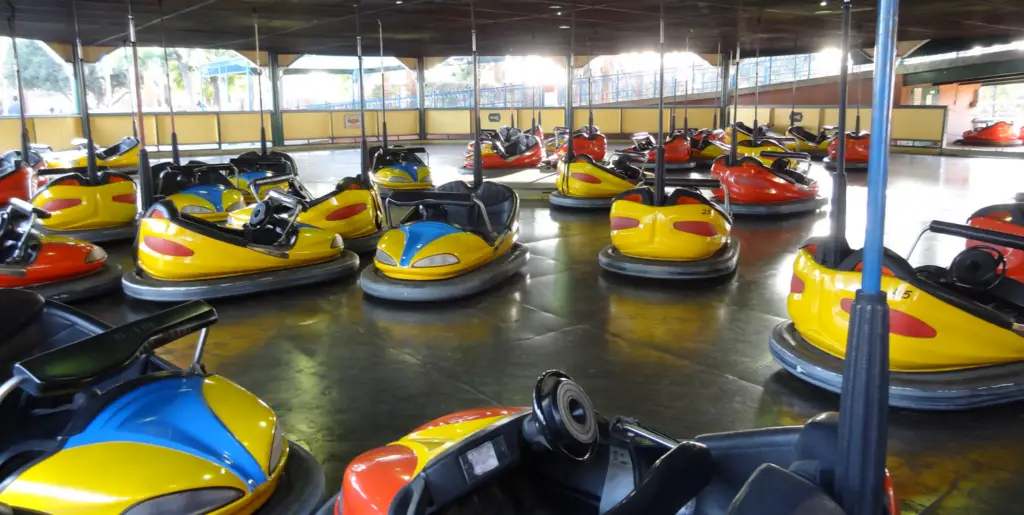
Bumper Cars delivered a uniquely interactive form of controlled chaos, combining the thrill of minor collisions with the satisfaction of vehicular revenge against friends and family members. The distinctive scent of electrical burning from the overhead grid and the continuous metallic screech of the pole connector scraping along the ceiling created a multisensory experience that remained unchanged for decades. The jarring impacts—which whiplash-inducing modern safety standards would never permit—were oddly addictive, especially when you successfully cornered someone who had been targeting you earlier.
The strange phenomenon of usually rule-following adults suddenly transforming into aggressive drivers with questionable ethics created a fascinating social experiment, revealing competitive personalities that remained hidden in everyday interactions. The bumper car arena featured its own unwritten etiquette and strategies—from the “wall-huggers” who drove defensively around the perimeter to the “bulls-eyes” who headed straight for the center of the action, creating collisions that could be felt in your teeth. The disappointment when the floor power shut off, bringing all cars to a sudden halt regardless of the dramatic chase or escape in progress, was universal—as was the immediate determination to get back in line for another round to settle unfinished business.
These classic rides provided more than just momentary thrills—they created generational memories and rites of passage that connected us across decades. Unlike today’s highly engineered experiences with their virtual queues and elaborate safety systems, these simpler attractions delivered raw, unfiltered excitement that felt genuinely risky in ways both terrifying and thrilling. The special courage required to finally try the Zipper, the camaraderie formed while waiting in line with strangers who would soon become temporary screaming companions, and the distinctive sounds and smells that instantly transport us back to those summer days—these are the sensory souvenirs we’ve carried through life. Perhaps what made these classics truly special was how they balanced genuine fear with absolute joy, creating experiences that taught us something about ourselves each time we worked up the courage to say, “Let’s go again!”


